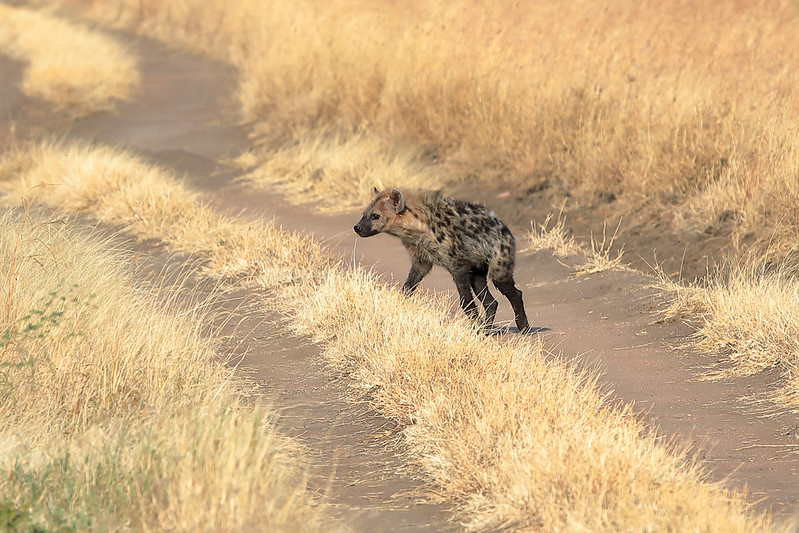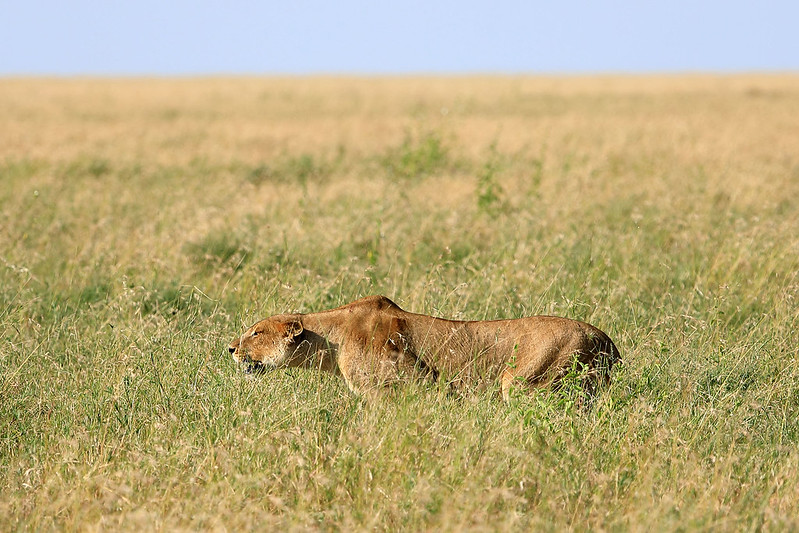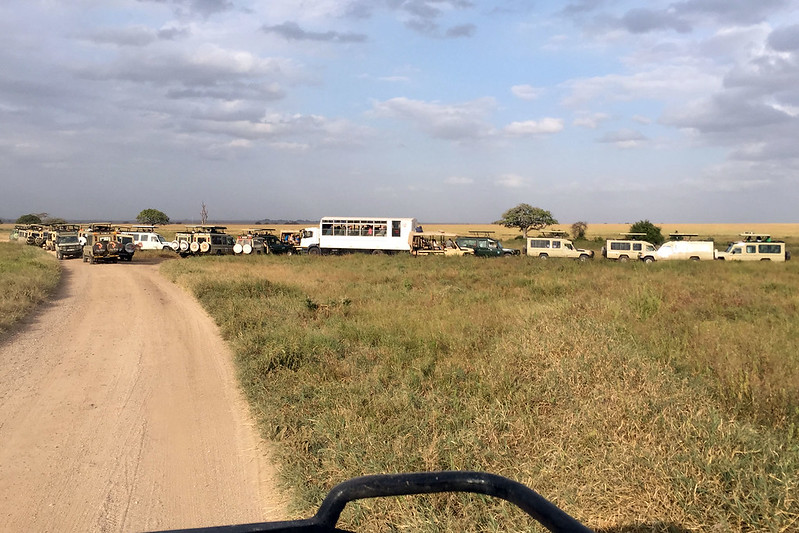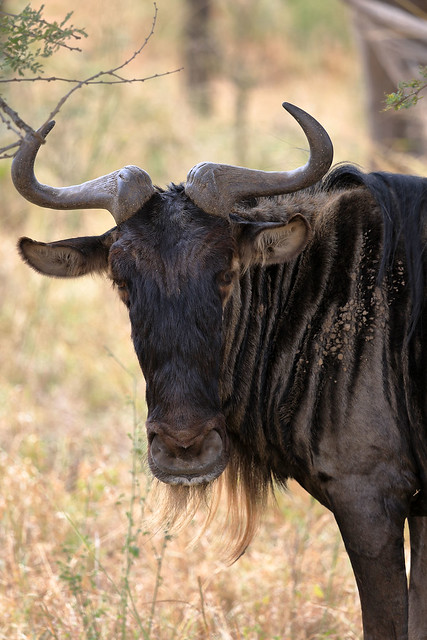Wednesday, 4 July, 2018. 18:16
I woke around 05:00, by the sound of animals just outside the tent. I realised it was zebras by the clopping and snorting. They grazed around for a bit, then suddenly they bolted away and it was quiet again. Later at breakfast the people at the other table were telling the staff that they heard zebras and also lions during the night!
We got up with the alarm and got ready for breakfast at 06:30. The menu was a choice of fresh fruit or muesli, plus pastries, and a hot choice of either banana pancakes, eggs benedict, or a full English breakfast. We both chose the muesli with natural yoghurt, and the pancakes. We also asked what pastries were available and the guy said banana bread, so we tried a thin slice of that each too.
 Banana pancakes for breakfast, at Nimali Central Serengeti camp |
After quickly returning to our room for a toilet break, we emerged to meet Timba a few minutes late. We sprayed ourselves with insect repellent for the tsetse flies, climbed aboard, and set off. Leaving the camp area we saw plenty of zebras. Over breakfast a staff member had told us they like being in the camp area as it’s safe for them.
We started off sighting some interesting birds on the drive away from the camp: a lappet-faced vulture perched high in a tree, waiting for the sun to climb into the sky so it could ride the thermals. A red-billed hornbill, with its impressively large and colourful red beak. And some chestnut-bellied sandgrouse, puttering around on the grass of the plain.
 Northern red-billed hronbill |
The first big sighting of the day happened when we reached the tree where we’d seen the leopard kill yesterday. This time, the leopard was there! It was in the tree, munching on its kill. And then something exciting happened: it decided to come down from the tree, carrying its meal. It set off through the grass away from us, and Timba said it was probably heading for another tree we could see about 200 metres away.
 The leopard leaving the tree with its kill |
Then something even more exciting happened. Timba pointed off to our right and said, “Hyenas!” There were two hyenas on the other side of the road, walking through the grass towards our car. Timba explained that leopards and hyenas are bitter enemies, because hyenas will often try to steal a leopard’s kill. But neither the leopard nor hyenas had noticed the other yet. We could see the leopard moving through the grass away from us, and the hyenas moving towards us from about a 90° angle to the leopard’s path. And then suddenly the hyenas changed direction. Timba said, “They’ve picked up the leopard’s scent.” They moved roughly in the leopard’s direction, but not exactly, searching for it in the tall grass. They closed in, and then headed straight for it, and Timba said they’d spotted the leopard, which was still oblivious. They got within about twenty metres and then all hell broke loose. The leopard bolted for the tree and the hyenas gave chase. One got within biting distance, but then stopped, and I wondered what had happened. Timba said the leopard had dropped its kill. It bolted for the safety of the tree while the hyenas converged on its dropped kill. This was an amazing display of nature, and we’d seen it all unfold before 08:30.
 One of the hyenas, stalking the leopard |
That wasn’t the only amazing thing to start the day either. Not long after we’d left the leopard scene, Timba stopped the car and said there was a lioness in the grass, stalking a group of Thomson’s gazelles that we could see off to the left. The lion was maybe 50 metres from us, crouching low in the grass to avoid being seen and approaching the gazelles slowly from downwind, as we could see the wind blowing the grass stalks over in her direction from the gazelles’ location. Timba said it was difficult for her as the grass was too short to provide good cover. The gazelles looked a bit skittish and he said they could tell something was up. The lion stopped and crouched low, hiding still for several minutes, still about a hundred metres from the gazelles. The suddenly the gazelles bolted, running directly away from the lion, and the game was up. The distance was too great, as Timba said a lion needs to be within about twenty metres to initiate a successful chase. She sat up in the grass and watched the gazelles run away. We’d been hoping to see a successful hunt, but it was not to be. Still, seeing this much was incredible, and it was still before 09:00!
 The lioness, stalking Thomson’s gazelles |
As the day progressed, we saw many more gazelles, zebra, wildebeest, impalas, and some giraffes, hartebeest, topi, and dik-diks. We saw more hippos, and elephants, including getting very close to two different groups of elephants: one a family group of females and young led by a matriarch, and late in the day a pair of large males who came very close to our car. Timba pointed out that one male was ready to mate, as you could tell by the constant dripping of liquid from his penis. The pair walked along together and a few times stopped to face one another, interlocking tusks and feeling each other with their trunks. Timba said this was socialising behaviour, to strengthen their male bonding.
 Male elephant bonding |
And we saw more lions. There was a small group sleeping close by the side of the road, in the shade of a tree. They didn’t do much. But then later after driving through a herd of zebra, Timba suddenly exclaimed, “Oh my god! There’s a male lion up on that rock watching the zebras!” We looked, and sure enough, there was a large male lying atop the nearby outcrop of rock, surveying his territory like Mufasa on Pride Rock. We were the only car there this time, and we drove as close as we could get on the road to have a good view of this lion. He saw us approaching and got up and we thought he’d disappear down the far side of the rock, but then he stopped and returned.
 “Mufasa” on Pride Rock |
And then late in the day we saw a male and female pair of lions, surrounded by cars. They were lying asleep in the sun, despite Timba having explained to us earlier that lions don’t like being in the sun and usually lie down in the shade of a tree. He said this must be a mating pair, as this is the only time a male and female lion will associate in a pair like this. They mate every 20 to 30 minutes, day and night, for up to seven days, except later in the period they start to get tired and the time between matings stretches out. The two lions stirred and began walking, and Timba said excitedly to be ready with my camera as they could mate at any second, and the act only lasts about ten seconds. But they didn’t, they merely crossed the road to the shade of a tree and lay down again, moving out of the sun. We waited a good further twenty minutes or more, but there was no sign they would wake up again, so eventually we left.
 The mating pair of lions |
Heading back to the camp, we came across a very large group of cars, ten or more, over on a parallel road, and wondered what they were looking at. Timba used his binoculars and said there was a leopard in the tree between us and them. We could see it from where we were, but the other cars were closer and also on the west side of the tree, so the afternoon sunlight was illuminating the cat better from their side. So we drove around, finding a connecting road to take us around the tree. As we did, we could see about ten more cars all converging rapidly on the same spot. The drivers use radio to inform others of interesting sightings, so they can convey their passengers to the sites, and Timba explained to us that a leopard was a holy grail, because they are so hard to spot. When we reached the good side of the tree, Timba exclaimed that there were two leopards in the tree! We could only see the legs and part of the lower body of the second one, as its head end was draped down the far side of the branch. He said this must be a mother and child, as leopards are solitary animals, and there’s no other case when two would sit together like this.
 The group of cars around the double leopard tree |
Besides these highlights of the day, we also saw dozens of different birds, including a group of ostriches, and later a lone male, three different types of eagles, a pygmy falcon, secretarybirds, yellow-billed storks, Rüppell’s and white-backed vultures, green-winged pytilias, purple grendadiers, African pied wagtails, white-bellied bustards, guineafowl, bare-faced go-away birds, and colourful lilac-breasted rollers including one I captured in flight when it displays its spectacular coloured wings.
 Secretarybird |
We had a first toilet stop at Seronera Airstrip, which had an administration building and served as a small airport, flying tourists in and out of Serengeti. Lunch was at a designated picnic spot in the park, with an overlook over a large pool full of hippos. We had packed lunches from Nimali, consisting of a square of quiche type thing, a chunk of roast chicken for me and a vegetable pastry for M., a sandwich on a burger bun (tuna for me and a vegetable relish for M.), a muffin, and a Granny Smith apple. I mentioned to Timba that these apples had first been grown in Sydney, not far from where we live. We also discussed what national parks we have in Australia.
 Monkey at Seronera Airstrip |
There were no other breaks during the afternoon, and it was continuous driving and animal spotting until we returned to the camp at about 17:30, having spent ten hours driving around the Serengeti. We’d seen a lot of different terrain: plains with scrub and many small trees, plains with tall grass and dotted with occasional acacia trees, plains with just grass and no trees, scrubland with red dirt highly reminiscent of outback Australia, rock islands jutting up from the plains, rounded hills, narrow rivers lined with palm trees, marshy land with pools deep enough for hippos, and also areas that had been burnt recently in controlled burns to revitalise the grassland.
Timba provided us with a lot of informative commentary on the life cycles and behaviours of the various animals we were seeing. He included some amusing asides, such as telling us that it was easy to tell male and female zebras apart, as males were white with black stripes while females were black with white stripes. He also said that wildebeest were leftover animals, assembled from the mane of a lion, the stripes of a zebra, the body of an antelope, but they had no spare brains when assembling them.
 Wildebeest, the leftover animal |
Other highlights of the day included seeing a group of half a dozen vultures right beside the road, next to a hyena, as well as two black-backed jackals hovering nearby. The hyena had made a kill and was guarding it, while the vultures and jackals were waiting to move in to scavenge the remains. And the final sighting of the day was when we were very close to our camp, when we saw three hyenas lying right in the middle of the road! The observed us lazily but didn’t move, and Timba went off road to drive around them.
 Black-backed jackals |
Eventually back at the camp, we rested up before dinner. This time I tried a Kilimanjaro beer, which was very similar to the Safari from yesterday. The Spanish group joined us at the bonfire tonight, and we learnt that they are not from Spain, but are a family spread across Panama, Costa Rica, and the USA, and they get together to travel like this twice a year. One woman told us that last night they had been sitting by the fire around 20:30 when some hyenas appeared nearby. The staff ran for the tents, and so they did too, terrified. The others joked about it but the lady seemed genuinely worried about it.
 Kilimanjaro beer, back at the camp |
We had dinner at 19:00 again. It was lentil soup with garlic bread, then pork chops with sweet potato and vegetables (the pork substituted by eggplant with cheese for M.), and a small crepe suzettes for dessert. Then we went back to our tent to shower and retire for the night.
